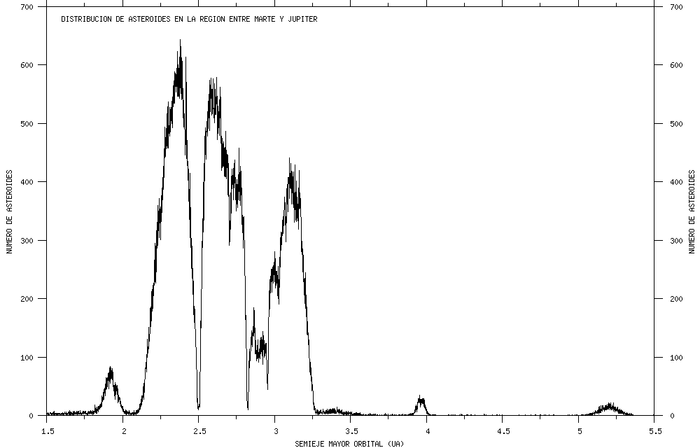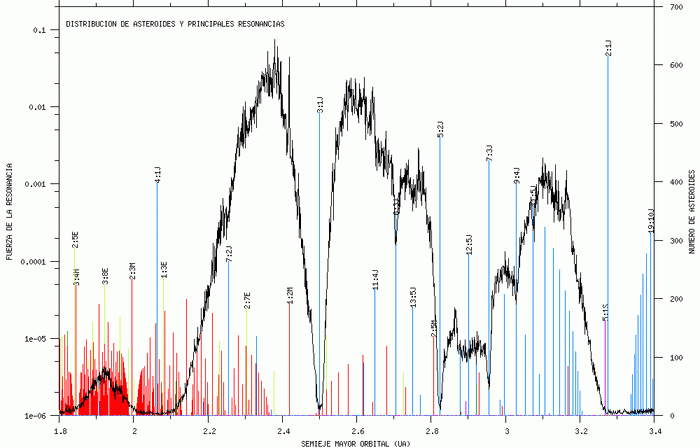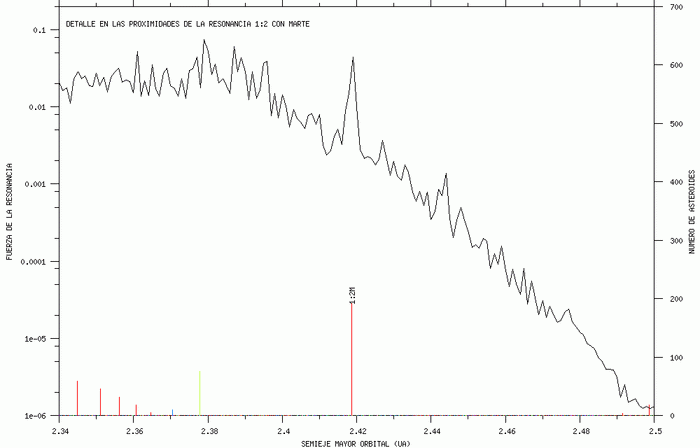The Polanas, the asteroids captured in the 1:2 resonance with Mars (original) (raw)
Abstract
We found there is a population of about 1500 asteroids captured in the 1:2 resonance with Mars. This means that when the asteroid completes one revolution around the Sun, Mars completes exactly 2. This finding breaks some paradigm (as the exclusive domain of Jupiter in the asteroid belt) highlights the importance of dynamic mechanisms such as the Yarkovsky effect on the orbital evolution of asteroids, and perhaps provides an answer to the dynamical evolution of certain families of asteroids (Nysa-Polana complex). This page explains the most basic aspects of the investigation. The technical details are in this manuscript to be published in Icarus.
1) The distribution of asteroids in the Solar System
Day after day (or rather night after night) hundreds of new asteroids are discovered. After several observations (the staff of the Observatorio Astronomico Los Molinos works on this), an orbit for each asteroid can be determined. The databases containing the orbital parameters of asteroids' orbits are of free access, for example MPCORB and ASTORB. The latter is maintained by Ted Bowell at Lowell Observatory, and in April 2011 it contained about 550,000 asteroids. Among them are the charruas (68853) Vaimaca and (73342) Guyunusa among otheruruguayan asteroids.
If we plot the number of asteroids according to their average distance from the Sun (or semi-major axis) we obtain the following picture:
This distribution is the result of 4500 million years of evolution. Originally the population of asteroids was more massive and uniform, but mutual collisions and chaotic evolution generated an erosion process. What we see today is the fraction of the population that could survive these erosion processes and have found a stable place in some stage of their orbital evolution.
The famous Kirkwood gaps are clearly seen, places where are few asteroids due to the existence of resonances with Jupiter that excite the eccentricity's orbits generating encounters and collisions between asteroids and the planets Mars and Earth and even with the Sun. So they can not stay there because they are highly perturbed. Also shows that there are concentrations in certain places: the "Hildas" at 3.97 AU (recall that the AU is the distance unit in the solar system and is equal to the mean Earth-Sun distance, which is about 150 million kilometers), "Trojans" at 5.2 AU and other smaller groups. These concentrations are due to "benevolent" resonances that serve as reservoir of asteroids. That asteroids are in fact mainly comets, because the frozen gases at such distances are common in the chemical composition of the bodies. The resonances are places where the movement of the asteroid is in perfect synchrony with the planet, as is exemplified below.
2) Resonances
Resonant movements only occur in very precise positions of the solar system because it is in those very specific places where the movement of the asteroid and the planet (usually Jupiter) are exactly synchronized. A little shift from that position the synchrony breaks. In the figure below we reproduce the region of the main asteroid belt including also the principal resonances that operate in the region:
In this figure we indicate not only the resonances with Jupiter but also with all the planets, with different colors. Light blue shows the resonances with Jupiter, Saturn in purple, red and green with Mars and Earth. 2:1J resonance, for example, means that when the asteroid turns 2 revolutions around the Sun, Jupiter has completed exactly 1 revolution. It is well known the destructive effect of the resonances 3:1, 5:2, 7:3, and 2:1 with Jupiter for example.
We also indicate the "strength" associated with each resonance. The higher is the line that represents the strenght, the greater the strength of the resonance. A weak resonance should not affect the movement of the asteroids, but a strong one yes. It is not trivial to make the calculation of the "strengths" of the resonances. For this issue we had to develop a method that we published in the journalIcarusand waswell received by readers. As a byproduct of this work, we first find a small group of asteroids in the 1:2 unusual resonance with the Earth (3 asteroids) and 2:5 with Earth (6 asteroids). We also found 4 asteroids in 1:2 resonance with Venus, which are added to the only one already knew. This suggests that the "terrestrial planets" may have some influence on the asteroid's orbits. The details of the method and some of the figures can be found followingthis link.
3) The excess of asteroids at 2.4184 AU
We note that it seems to be a constructive effect in the 1:2 resonance with Mars because in this position there is a peak, an excess in the distribution of asteroids. If we zoom in this region we see that better:
Exactly at the 1:2 resonance with Mars there is an excess of asteroids. The excess is about 300 asteroids when compared with the number of asteroids in the neighborhood.
Could this concentration reflect a real effect of the 1:2 resonance with Mars?
Could the resonance operate as a protection mechanism against the dynamical erosion in the region?
We set out to answer these questions. For that we chose from the database ASTORB the 4000 asteroids nearest to the peak and studied its orbital evolution 1 million years into the future. This can be done with programs likeEVORB, Mercury,Swifter or OrbFit, which are in the public domain. After several days of calculations the computer finished the numerical integration and then**we found that approximately 1500 asteroids, a number greater than the excess observed in the population, are in resonance.** Then we have confirmation that the 1:2 resonance with Mars acts as a reservoir against the action of natural erosion of the population of the asteroid belt. Maybe something similar to what happens with the Hildas and the Trojans of Jupiter.
4) The distinction of being a resonant 1:2 with Mars
The fact that the asteroids are in 1:2 resonance with Mars implies that the motion of asteroids with respect to the Sun-Mars rotating system is very particular. In the next figure we see the movement in the rotating system of a fictitious asteroid close to the resonance but outside of it. In the figure we see the Sun (yellow dot), Mars (red dot) and the asteroid's trajectory green light "from above", or as an astronaut would see it located in the north of the plane of the solar system, from several AUs away and traveling around the sun just above Mars.
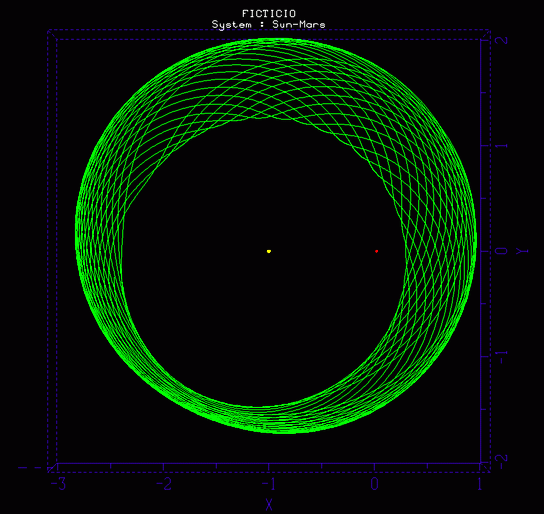
Over time the asteroid describes a kind of mesh in this system, at certain times dangerously approaching the planet Mars. Now let's see (142) Polana, a real asteroid captured at resonance:
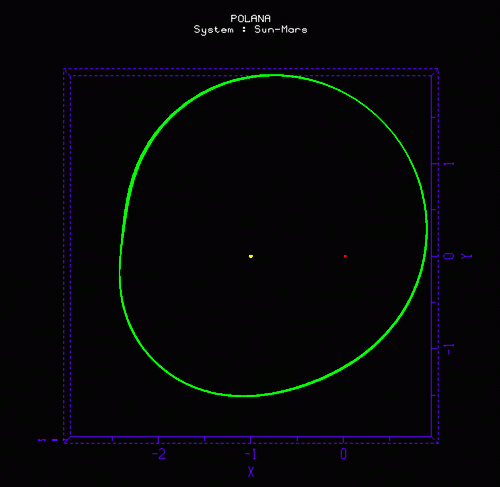
The synchrony of movements is evident, the asteroid never approaches Mars. All 1:2 resonant trajectories are analogous to this. In the next figure we see one of the asteroids more "immersed" in the resonance, the asteroid 2003 BO71:
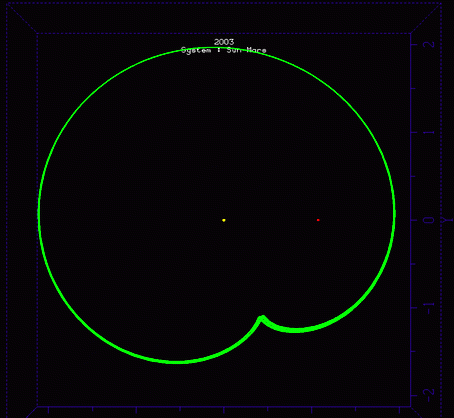
...and now the same path but in spatial perspective:
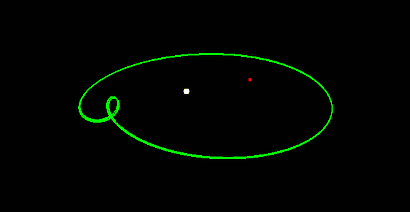 java applet del asteroide 2003BO_71
java applet del asteroide 2003BO_71
The Mars 1:2 resonant asteroids design a kind of loop in the Sun-Mars system. This loop can be in different configurations in the Sun-Mars system. The resonant motion does not occur by chance but is a state of equilibrium to where asteroids can evolve. These graphs were obtained with the programNEAPLOT.
5) Escaping from the resonance
In order to analyze the temporal evolution of this population we took a sample of 100 resonant asteroids and we integrated them by 1000 million years under the gravitational force generated by the Sun and planets. At the end of this period still had 70 captured asteroids which implies an evolution very stable over long timescales. The following animation shows the evolution in the space of semimajor axis and eccentricity (a,e) over 1000 million years. Diffusion can be seen that gradually pushes the asteroids away from the resonance:
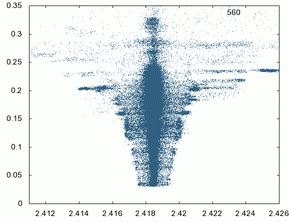 100 asteroids over 1000 million years (animated gif, 6MB)
100 asteroids over 1000 million years (animated gif, 6MB)
After a detailed analysis of the orbital properties, sizes and surface characteristics we come to the conclusion that the resonant asteroids have similar surface characteristics to non-resonant ones. But both their orbital eccentricities and size distributions are different. The resonant orbits are more eccentric and there is a subtle but significant excess of small asteroids in the resonance. Why?
6) The Yarkovsky effect
Our preliminary study, considering only the law of universal gravitation, is not complete because we can not neglect the Yarkovsky effect, which is a thrust generated by the asymmetric emission of solar energy absorbed by the asteroid. This new force is extremely weak but on a scale of millions of years may be significant for small enough asteroids. Another effect that we are also considering is the eventual collisions between asteroids, which ultimately disrupt the resonant motion. Considering these effects we find that small asteroids, say tens of meters in diameter, can remain in the resonance about 10 million years. Asteroids of aproximately 1 km in diameter may remain around 100 million years and asteroids of 10 km or more in diameter may remain about 1000 million years trapped in the resonance. This means that the current population of resonant asteroids have different ages depending on the size of the asteroid, the smallest being the youngest. 80% of known asteroids that are in the resonance have diameters between 1 km and 55 km.
Just as these effects eliminate asteroids from the resonance, others are injected into the resonance and the balance between the injected and ejected asteroids is what would give a concentration of asteroids in the resonance. To test this hypothesis we worked with a physical model that included universal gravitation, the Yarkovsky effect and collisions. After 2 years of CPU time (distributed over several processors) and after analyzing some 200 million lines of data we showed that this model predicts a concentration of asteroids in the resonance. Not only that, we also found that into resonance there should be more small asteroids than outside, which is one of the characteristics of the population.
That means that in principle the present population of asteroids in 1:2 resonance with Mars could be explained by the dynamics generated by the Yarkovsky effect plus collisions.
The following animation shows a fictitious asteroid population that migrates due to the Yarkovsky effect from right to left across the resonance. The triangular shape that arises is due to the dynamical effect of resonance. Time in millions of years is outlined in the top right:
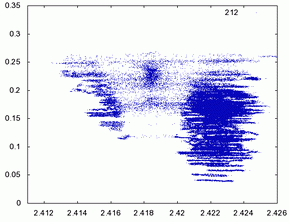 Capture in resonance and escape by the Yarkovsky effect (animated gif, 7.3MB).
Capture in resonance and escape by the Yarkovsky effect (animated gif, 7.3MB).
7) Some conclusions
There is a large population of asteroids (about 1500 known) that remain in some way protected by a resonance, but surprisingly, in this case with Mars.
The population is not captured forever in the resonance but some asteroids escape and other get in at different time scales, according to their size.
Jupiter is not the only planet that dominates the dynamics of asteroids. Also Mars, whose mass is 3000 times lower than that of Jupiter, operates efficiently and in this case as a protective mechanism. For the first time we found a low-mass planet that generates the existence of a large population of resonant asteroids.
The largest member of this population is the asteroid (142) Polana with a diameter of 55 km, so that this population might be called "the Polanas".
The dynamics generated by the Yarkovsky effect explains the observed concentration of asteroids and the excess of small asteroids in the resonance.
Large asteroids may remain captured in the resonance by about 1000 million years.
8) Open questions
The Yarkovsky effect can not explain the capture in resonance of an asteroid as big as Polana. Polana maybe get into resonance after a slow chaotic diffusion. Another possibility is that it has not fallen into the resonance but captured by it. Suppose that the resonance could move from its place, as is moving is capturing and dragging captured asteroids. This was the mechanism that captured Pluto in the 2:3 resonance with Neptune, due to Neptune's migration. A small migration of Mars could explain the capture in resonance of Polana and large asteroids. Our preliminary studies indicate that it is possible, but ... does Mars has been running from its position?
